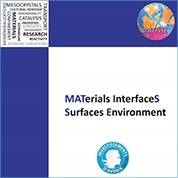MATERIALS UNDER EXTREME CONDITIONS
Objectives
From the study of the nature and structure of deep Earth and planetary interiors to the synthesis of new materials (ultra hard materials or superconductors), this axis gathers unique experimental skills in high pressure (HP) and high temperature research with the most advanced theoretical methods to characterize and predict new structures and properties of materials under extreme conditions. Main axis topics are:
- In-lab characterization of deep earth and planetary interiors.
- New physical and chemical properties of materials under high pressure.
- Synthesis of new materials (ultra hard materials or superconductors) through high‐pressure out‐of‐equilibrium thermodynamic routes.
- Characterization of metastable materials: from glass transition to out of equilibrium systems.
Partner teams
IMPMC, LCMCP, LPTMC, LRMH, ISTEP, PHENIX, C2RMF, ENS-Geology, with complementary competences in chemistry, material science, physics and geoscience.
Funded projects
- Physics and planetary science
- Primitive Earth Degazing – Iodine and Xenon cycles: C. Leroy, PhD project (C. Sanloup ISTEP & H. Bureau IMPMC).
- Investigating the Phase Diagram of aqueous electrolyte solutions under extreme conditions: A. A. Ludl, PhD project (L.E. Bove IMPMC/M. Salanne PHENIX/A.M.Saitta IMPMC)
- Earth science and chemistry
- The intermediate and deep earthquakes: from the lab to the field: T. Ferrand, PhD (A. Schubnel ENS Geology and ISTEP
- The partitioning of highly siderophile elements during core formation: Terry-Ann Suer PhD (G. Fiquet IMPMC and L. Remusat LMCM (now IMPMC)
- Chemistry and Materials science
- Nanocomposites borates in extreme conditions: Rémi Grosjean PhD (Y. Le Godec IMPMC and D. Portehault LCMCP)
- NH3 mixtures: a new route to synthesize ionic or superionic compounds at mild conditions: C. Liu Post-D (F. Finocchi INSP and S. Ninet IMPMC)
First Results
The on-going research projects already gave rise to first promising results (1 publication, 2 high impact papers under review, 8 oral and 9 poster communications and 1 invited talk to international conferences). They also promoted new collaborations both between MATISSE teams and with international experts (Dr. A. Goncharov, Geophysical Lab, Prof. Th. Loerting, Innsbruck University, Prof. P. Salmon, Bath University, Prof. E. Gregoryanz, Edinburgh University, Prof. P. Mc. Millan, University College London, Prof. N. Dubrovinskaia, Universität Bayreuth).
International visibility
International visibility of Axis 5 teams has strongly benefited from the organization of International Conferences (JCM25 Colloquium for EPS, Water Europe Conference, European High Pressure Research Conference 2014), International schools on extreme conditions research (EHPRG 2014 school), and Invited Lectures by international experts in the field (Prof. E. Gregoryanz, Edinburg Center for High Pressure Research, Prof. A. Goncharov, Geophysical Lab, Prof. Othani, Tohoku University), all these events supported by MATISSE.
Selected Highlights
Investigating the Phase Diagram of aqueous electrolyte solutions under extreme conditions: A. A. Ludl, 3rd year PhD project (L.E. Bove/M. Salanne/A.M.Saitta)
The aim of this project is to explore the p-T phase diagram of common salt (NaCl) water solutions and to probe the existence of salty ices, under the conditions relevant for icy bodies in the Universe. The metastable p-T phase diagram of NaCl was characterized (Ludl et al, PCCP accepted); NaCl-ice VII was synthetized by annealing an amorphous hyperquenched solution at HP and its structure solved (Ludl et al. in preparation); the suppression of symmetric ice X phase at Mbar pressures was observed (Bove et al, PNAS under review).
Primitive Earth Degazing – Iodine and Xenon cycles: C. Leroy, 3rd year PhD project (C. Sanloup & H. Bureau).
The aim of this PhD project is to characterize the behavior of xenon and iodine in the ocean generated during Earth formation (magma ocean), where the differentiation process bringing the creation of the various terrestrial envelopes occurred. To date these early events, the isotopic reference system is the couple 129 I / 129 Xe (half-life of 15.7 Ma). We proved iodine and xenon differential behavior in during magma degasing in presence of aqueous fluids (Leroy et al, under submission) .The structural characterization of an amorphous silicate at HP-HT, analogue to the magma ocean, shows the Xe incorporation in the magma via a covalent Xe-O bond (Leroy et al, under review).
Benefits of MATISSE
Numerous applications from grinding industry to cultural heritage materials and new high pressure technologies have arisen from these research projects. 2 patents applications have already been filed, new research contracts (ANR International-PACS, ANR Blanc-MOFLEX, FNS grant s-ICE, Dim Oxymore from Région Ile-de-France, among them) have been initaited by first results obtained in the frame of MATISSE, new contacts with industry (among them St Gobain, MG63, Omega) have also been established.
Also in the section
Key figures
MATISSE :
4 disciplines
- Chemistry
- Physics
- Earth Science
- Cultural heritage
18 partners
400 researchers
Contact
Direction :
Florence Babonneau
Administration :
Laurence Bonnet-Lericque
Communication :
Tél. (33) 1 44 27 62 36




